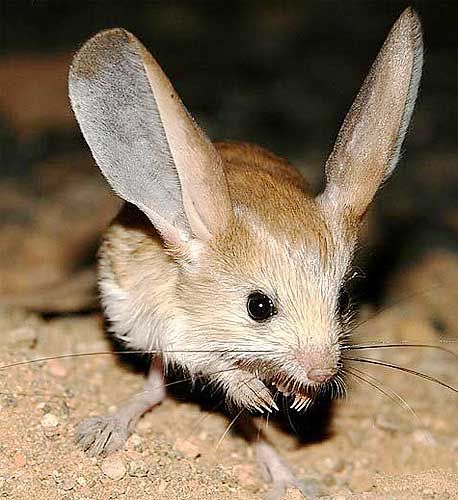
THE GERBOA.
UNCLE AMBROSE was a traveler; he had been to California and the 'Rocky Mountains, and -to South America; he had climbed the Alps, and strolled under the deep blue sky of sunny Italy; he had paddled his canoe down the Jordan, in Palestine; and he had even visited Africa. He liked to study about the things God has made; and so he went to these far-off countries to find out more about them than he could learn from the books he had at home.
The children were always glad to have, their uncle come to their house; for they never got tired of listening to his stories of other lands, or looking at the curious things he had brought back with him.
One day when they were all sitting in the dining room after dinner, a little mouse ran across the floor. The girls scrambled up into their chairs, and Uncle Ambrose and the boys laughed at them. Mousie didn't know what to make of such strange actions, and suddenly stopped in the middle of the floor, and looked up at the girls to see what it all meant. Then he grabbed a bit of food they threw at him, and scampered to his hole in the floor.
"That makes me think," said Uncle Am, as the children familiarly called him, "of an animal I saw once in Northern Africa.
"One day when we were riding over a dry, sandy place, we came across a number of queer-looking holes in the ground. Getting off our horses, we stepped carefully up to these holes to learn, if we could, what made them; but before we could get near enough to see, out jumped a number of little creatures that looked not unlike the mouse you just saw. They were as large as a good sized rat."
"Did you catch any? " they all asked in a breath.
"It was a hard chase," he replied; "we set the dogs after them, and they ran till nearly sunset before they caught any. One of our party made a picture of him for each of us."
Uncle Am then took from his portfolio on the parlor table the picture, and showed it to them.
"This animal," said he, "is called the gerboa.”
Its fur is of a light dun color with dashes of yellow, and on the underside is nearly white.
"They like company, and so a good many of them live together. They are hard to catch. The natives like them to eat, but they know that they cannot- catch them by chasing them; so they stop up as many of their burrows as they can; and when the little fellows rush out of those left open, the people kill them. We cooked one that we caught, but did not think it tasted very well.
"The bottoms of the feet are well covered with stiff, bristling hair, which is a good thing to protect them from the hard, burning soil of the country where they live.
"The gerboa never comes out in the daytime to get anything to eat, but always waits until night, when he goes out to get roots and grain. Yet he sometimes goes outside the door daytimes to play with his neighbors or to lie in the warm sunshine. His teeth and claws are so strong that he can gnaw a hole through the thin layers of stone under the sand.
"His forefeet are short, and his hind ones long.
His tail is also long, something like the kangaroo's, and has at the end a tuft of hair, which is black at first, but at the very tip is white.
"When the gerboa wants to run, he raises him-self up on his hind feet, and curving up his tail, gives such great leaps that a trained greyhound has hard work to catch him.
"We thought we would see if he could leap without his tail; so we cut one of the little fellow's tails off. We found that when his tail was partly cut off, he could not jump nearly so far as before; and after we cut it all off, he was afraid to leap at all; and when he rose up on his hind feet, he could not sit up, but would always roll over on his back.
"So we see that many of these things about animals that look so queer to us are just as necessary to them as our hands and feet are to us,"
W. E. L.